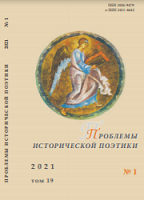Живопись al fresco «Воскресение Христово» в «итальянском» вкусе в романе И. С. Тургенева «Отцы и дети»
The Italian-style al Fresco Painting The Resurrection of Christ in I. S. Turgenev’s Fathers and Children
Author(s): Gennady KarpenkoSubject(s): Christian Theology and Religion, Visual Arts, Studies of Literature, Russian Literature, 19th Century, Eastern Orthodoxy
Published by: Петрозаводский государственный университет
Keywords: Ivan Turgenev; “Fathers and Children”; Resurrection of Christ; Italian style; desacralization; Orthodoxy; Descent into Hell; sacrament; theology of three days; liturgical remembrance; hierotopy;
Summary/Abstract: The article focuses on the unsolved mystery of the novel by I. S. Turgenev Fathers and Children - the Italian-style al fresco painting The Resurrection of Christ, located above the entrance to the church at the entrance to the Odintsova estate. None of the researchers and commentators of Turgenev’s novel were puzzled by the question: what does “Italian-style” mean in the Easter image? Meanwhile, Turgenev directly points out that, instead of the gateway Orthodox icon, there is a religious painting The Resurrection of Christ (al fresco painting) in the church, where both the sacrament itself and the outsider witness (“a swarthy warrior in a spiked helmet in the foreground”) are presented. In the Orthodox Easter iconography, however, an outside figure is an unacceptable detail, and the sacrament of the Resurrection as the highest sacred reality in accordance with the spirit and letter of the Gospel was not depicted. The Easter sacrament was replaced by the scene of the Descent into Hell, but such an icon was still called Resurrection. Meanwhile, canonically, the procession of Christ is captured, when the Savior does not descend into hell, but rises from there on the icon of the Resurrection of Christ/Descent into Hell: he leads Adam and other biblical heroes out of the underworld by “grabbing of the wrist.” In this way, the Resurrection of Christ begins with the salvation of man, with co-resurrection. In the value and semantic space of the novel, the Orthodox icon of the Resurrection of Christ/Descent into Hell is concealed behind the “Italian” fresco-veil. If Turgenev knows the “Italian” semantics of the Resurrection, then it is quite natural that the author is more familiar with the semantics of the Orthodox icon from liturgical recollection and makes it covertly actual. The behind-thescenes presence of the icon of the Resurrection of Christ/Descent into Hell and everything that is liturgically and theologically associated with it and experienced transubs the structure of Fathers and Children. The Easter hierotopy of the novel, outlined by the Orthodox icon and supported by the prayerful hopes of the finale 1) creates a very special, breathtaking and enlightening value space, correlated with eternity, the infinity of the spiritual, which affirms, elevating all present to endless life through participation; 2) sets up the supertext dimension, gives rise to the motive of transcendental hope: “You will not leave my soul in hell”; 3) and also strengthens the Russian word as the Christocentric foundation of Russian culture.
Journal: Проблемы исторической поэтики
- Issue Year: 19/2021
- Issue No: 1
- Page Range: 140-172
- Page Count: 33
- Language: Russian

